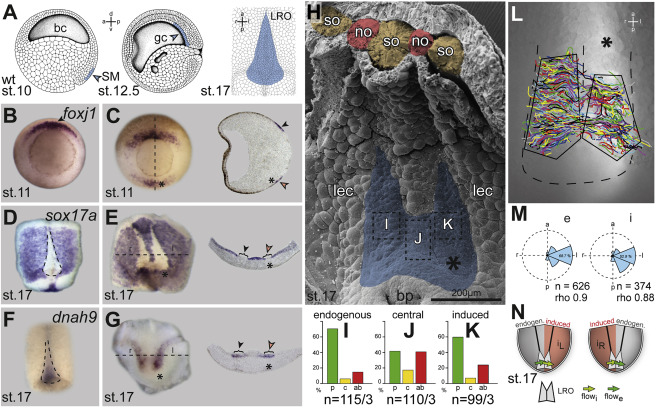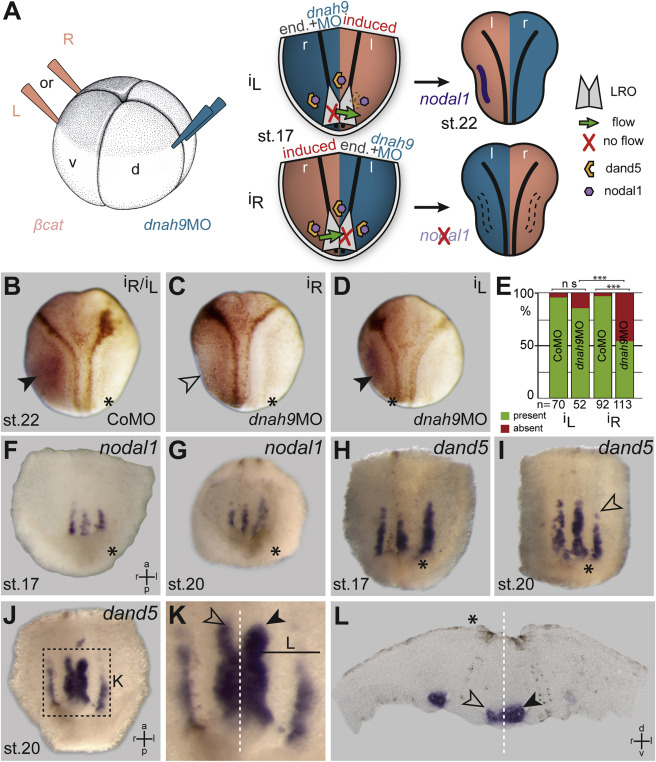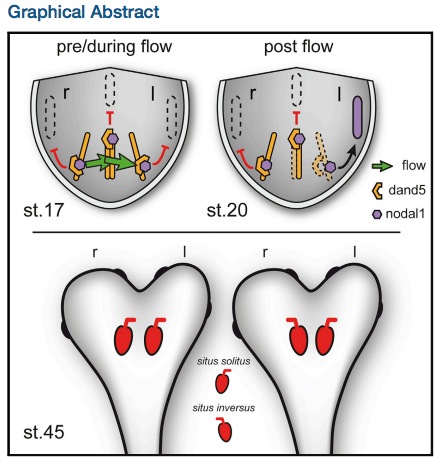Leftward Flow Determines Laterality in Conjoined Twins
Curr Biol. February 20, 2017, 27 (4): 543-548.
Tisler M, Thumberger T, Schneider I, Schweickert A, Blum M.
View article at Current Biology.
View article on Pubmed.
View article on Xenbase.
Abstract
Conjoined twins fused at the thorax display an enigmatic left-right defect: although left twins are normal, laterality is disturbed in one-half of right twins. Molecularly, this randomization corresponds to a lack of asymmetric Nodal cascade induction in right twins. We studied leftward flow at the left-right organizer (LRO) in thoracopagus twins in Xenopus, which displayed a duplicated, fused, and ciliated LRO. Cilia were motile and produced a leftward flow from the right LRO margin of the right to the left margin of the left twin. Motility was required for correct laterality in left twins, as knockdown of dynein motor dnah9 prevented Nodal cascade induction. Nodal was rescued by parallel knockdown of the inhibitor dand5 on the left side of the left twin. Lack of Nodal induction in the right twin, despite the presence of flow, was due to insufficient suppression of dand5. Knockdown of dand5 at the center of the fused LRO resulted in asymmetric Nodal cascade induction in the right twin as well. Manipulation of leftward flow and dand5 in a targeted and sided manner induced the Nodal cascade in a predictable manner, in the left twin, the right one, both, or neither. Laterality in conjoined twins thus was determined by cilia-driven leftward fluid flow like in single embryos, which solves a century-old riddle, as the phenomenon was already studied by some of the founders of experimental embryology, including Dareste, Fol and Warynsky, and Spemann and Falkenberg.
 ,

Figure 1. Leftward Flow at the Fused LRO in &beta,cat-Induced Conjoined Twins (A) Development of the LRO at the Xenopus gastrocoel roof: the superficial mesoderm (SM) involutes during gastrulation to give rise to the GRP during early neurulation, which is shown in a dorsal explant in a ventral view on the right (blue). (B and C) Endogenous (closed arrowhead) and induced (open arrowhead) SM marked by foxj1 expression in a singleton (B) and a conjoined twin (C, &lowast,, injected side). Note that the two SMs are clearly separated. (D&ndash,G) Ventral views of dorsal explants of singleton embryos (D and F) and conjoined twins (E and G). GRP tissues are highlighted by the absence of sox17a (D and E) and the presence of dnah9 transcripts (F and G). Closed arrowhead, endogenous GRP, open arrowhead, induced GRP. Note that the GRPs are posteriorly fused in the twins (E and G). (H) Scanning electron micrograph of representative twinned GRP (blue). (I&ndash,K) Compilation of cilia polarization in endogenous (I), fused central (J), and induced (K) parts of three twinned GRPs (n, number of cells). (L and M) Leftward flow at twinned GRPs. (L) Tracks of fluorescent beads. (M) Directionality of flow. (N) Schematic representation. a, anterior, ab, absent, bc, blastocoel, bp, blastopore, c, central, d, dorsal, e, endogenous twin, gc, gastrocoel, i, induced twin, l, left, lec, lateral endodermal cells, no, notochord, p, posterior, r, right, so, somite, st., stage, v, ventral. &lowast,, induced twin. See also Figures S1 and S2 and Movies S1 and S2.

Figure 2. Leftward Flow Is Required for nodal1 Expression in Conjoined Twins (A) Injection scheme and predicted nodal1 expression in CoMO- or dnah9MO-injected embryos following &beta,cat-induced twinning on the left (iL) or right (iR) side. (B&ndash,D) Left-sided nodal1 expression (closed arrowhead) in CoMO-injected twins (B) was absent (open arrowhead) in dnah9-injected specimens upon twinning on the right (C) but present (closed arrowhead) when the induced twin was placed on the left of the endogenous embryo (D). (E) Summary of nodal1 expression in the induced twin (green, present, red, absent, n, number of analyzed specimens). &lowast,&lowast,&lowast,p <, 0.001, ns, not significant. (F&ndash,L) nodal1 (F and G) and dand5 (H&ndash,L) expression in twinned GRPs of flow (F and H) and post-flow (G and I&ndash,L) embryos. Arrowheads, non-reduced dand5, open arrowheads, reduced dand5. Note that dand5 was clearly reduced on the left side of the left embryo (open arrowhead) but only partially in the left half of the fused central domain. &lowast,, induced twin. See also Movie S3.

Graphical abstract: Organ asymmetry is normal in left and randomized in right conjoined twins. Tisler et al. report that cilia-driven leftward flow determines laterality in conjoined twins like in singletons. The right twin is randomized because flow is insufficient to repress the Nodal inhibitor dand5 in the center domain between the twins.
